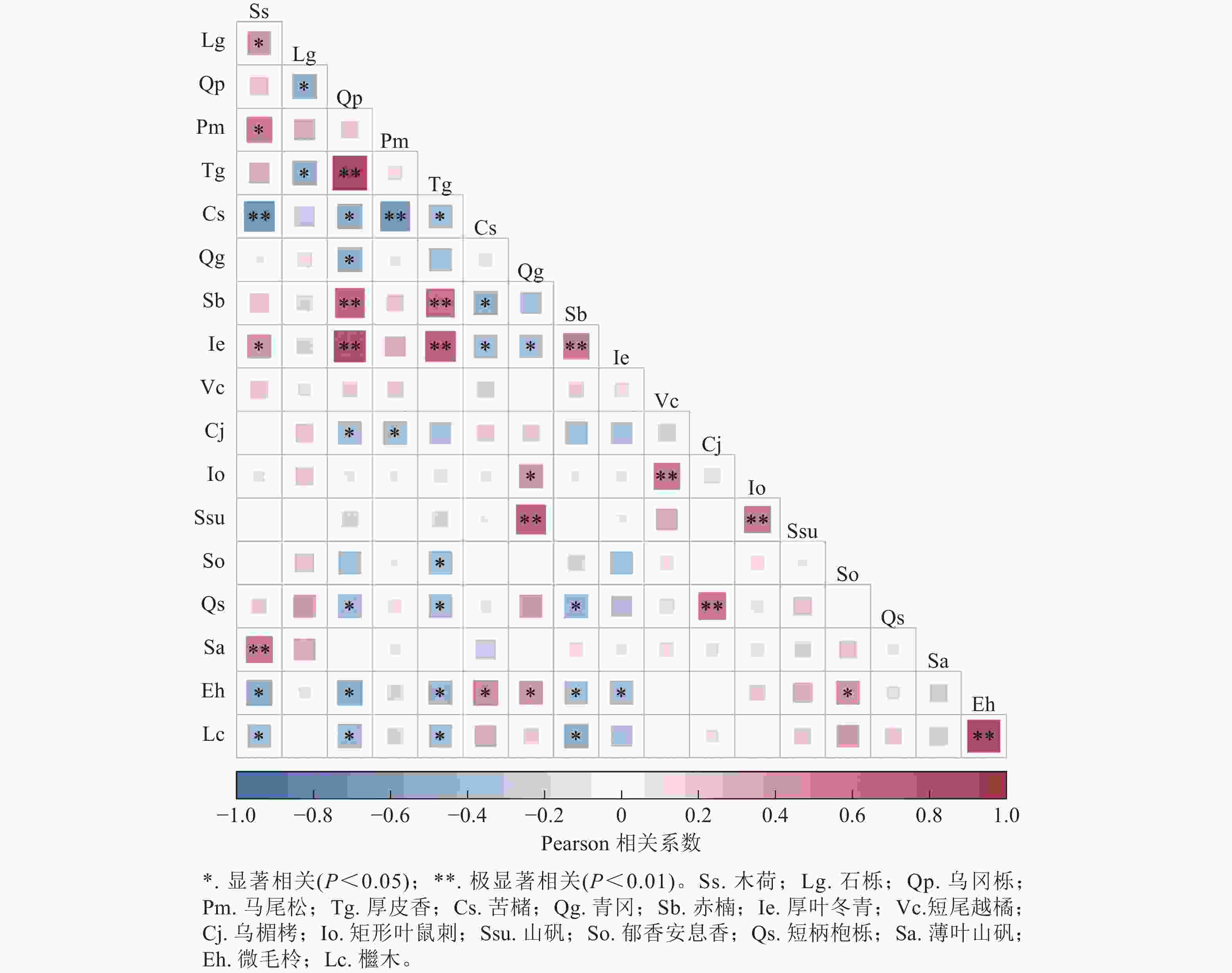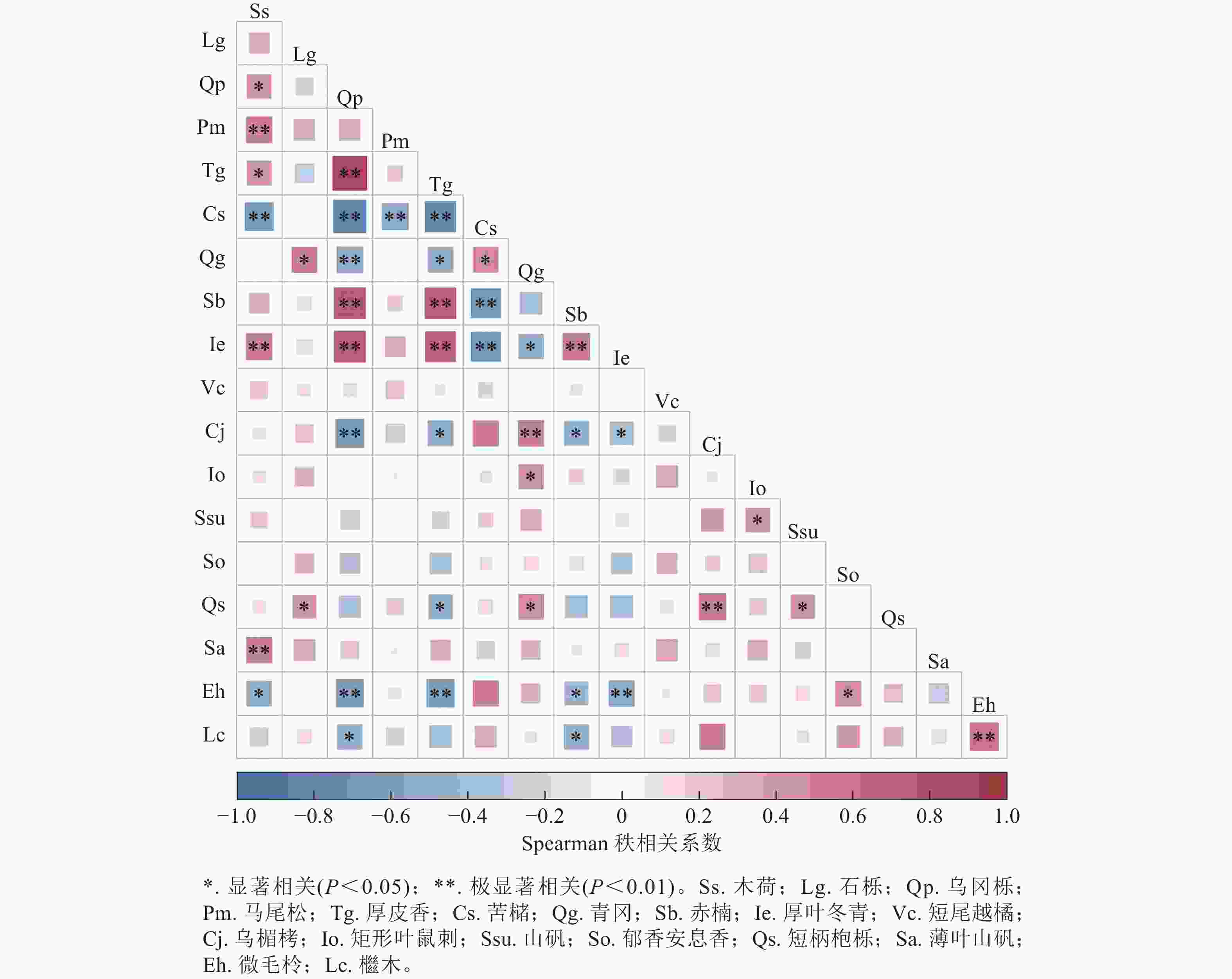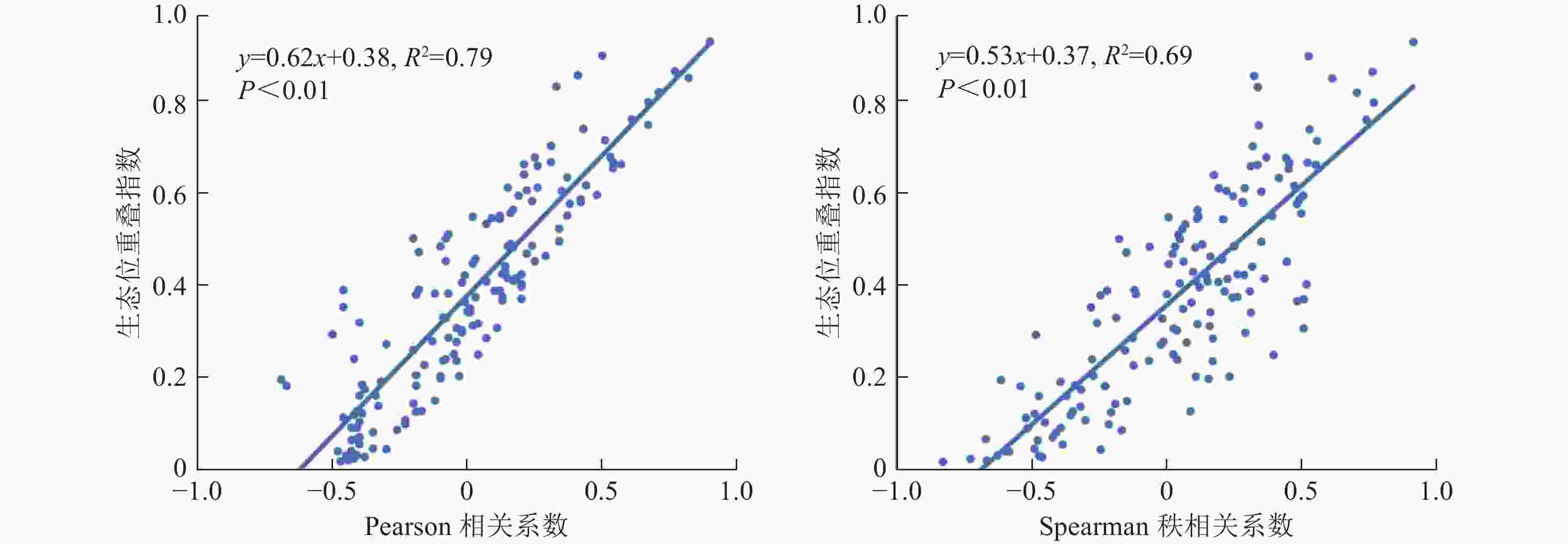-
植物群落是不同植物种类在自然界中相互作用和相互依存的生命共同体[1]。群落中的每一种植物都与其他生物相互联系[2],共同影响着能量流动、营养循环以及整个生态系统的功能和健康状况。常绿阔叶林是亚热带地区的地带性植被,在中国分布最广,生物多样性高,群落组成复杂,生物资源量大,是浙江省境内常见的森林类型[3]。
种间联结性可以表征生态系统的稳定性和动态变化[4],种间竞争、共生及其他更为复杂的相互依赖,在生态系统中发挥着重要作用,影响着物种的生存和繁衍,决定着群落的健康状况和发展趋势[5]。生态位分析是探究物种与环境互动的关键方法[6]。生态位宽度可以对种间关系进行量化描述,反映物种对环境的适应和资源的利用[7];生态位重叠度反映物种之间关系的紧密程度,以及物种对资源的利用效率和适应能力,体现为2个物种对相同资源利用的重叠情况。目前,很多学者通过生态位和种间联结的方法对浙江境内常绿阔叶林的年龄结构、萌生特征[8]、群落垂直层次、树种空间分布以及不同退化阶段常绿阔叶林恢复技术[9]进行了研究,如金则新[10]对浙江天台山常绿阔叶林的种间联结性研究发现:随着群落结构进入稳定阶段,喜光的先锋树种(如马尾松Pinus massoniana)年龄结构趋向衰退型,而甜槠Castanopsis eyrei、木荷Schima superba等优势种具有增长、稳定和发展的年龄结构。周刘丽等[11]对浙江天童枫香Liquidambar formosana群落种间关系研究发现:不同垂直层次(乔木、亚乔木、灌木)物种间存在显著联结性与相关性,乔木与亚乔木间联结性较弱,而与灌木层显著正相关。这种层次间的互补性和相似性揭示了物种在群落中的生态位和资源利用策略,也为生物多样性保护提供了科学依据。詹小豪等[12]发现:浙江建德天然次生林群落主要乔木树种空间分布以聚集为主,种间关系以不显著正联结为特征,揭示了群落演替初期的生态位分布与种间互动模式。这些研究为浙江境内常绿阔叶林的更新恢复及可持续经营提供了一定的理论依据。
白露山又称玉带山,是浙江省兰溪市内著名的自然景观和生态屏障,为浙江省风景名胜区。燕山运动形成的块状山体,造就了其浙江中部典型的常绿阔叶林特殊结构,代表着浙江中部常绿阔叶林的特质[13]。近年来,对该区域及周边常绿阔叶林群落的研究主要集中在木本植物种群生态位[14]、群落特征[15]、优势乔木树种更新[16]等,但尚未开展对白露山风景名胜区常绿阔叶林群落生态位及种间联结性的研究。因此,在该风景名胜区内建立1 hm2生物多样性长期固定监测样地,并进行系统调查,旨在探明该区域常绿阔叶林木本植物群落的结构和功能、种间关系、动态演替等特征,以期为白露山常绿阔叶林可持续发展和森林经营提供基础,同时为浙江中部常绿阔叶林的演替及生物多样性保护提供理论参考。
-
白露山风景名胜区面积为13.73 km2,最高海拔为439.7 m。该区地处亚热带季风气候区域,湿润温暖,四季分明,夏秋季高温,冬春季偏寒,伏旱明显,属于典型盆地气候。年平均气温为17.5 ℃,年平均降水量为1 476.5 mm,年平均相对湿度为76%,年平均日照率为43%,年平均无霜期为256 d[17]。土壤发育于侏罗系上统劳村组长石石英砂岩、钙质粉砂岩、泥质粉砂岩夹英安质晶屑凝灰岩风化残坡积物,为砾质砂壤的红壤土类[18]。1 hm2生物多样性长期监测样地西南角地理坐标为29°22′23.73″N,119°23′2.57″E。
-
于2023年8月,在全面踏查的基础上,选择具有代表性的常绿阔叶林,建立1个面积为1 hm2的生物多样性长期固定监测样地,沿正北方向设立,东坡,坡度为39°。样地下坡郁闭度较高,土层较厚,上坡林窗面积较大,岩石裸露率高,样地内树种多呈聚集分布及随机分布特点。用全站仪等测绘仪器将样地分成25个20 m×20 m的小样方,平均林窗面积为23.05 m2。以聚氯乙烯管为样方边界;每个20 m×20 m样方的西南角为调查的坐标原点,对样地内胸径(DBH)≥1 cm的木本植物个体进行全面调查,记录树种的种名、树高、胸径及位置[19]。
-
通过物种重要值(VI)确定群落木本植物的优势种,计算方法参考马克平等[20]。
-
使用Levins生态位宽度(BL)、Shannon生态位宽度(BS)计算木本植物优势种生态位宽度,并使用Pianka指数(Oik)计算生态位重叠指数。计算方法均参考 PIANKA[21]。
-
利用方差比率法(RV)对物种的总体关联性进行检验[22]。
$$ {R}_{{\mathrm{V}}}={S}_{T}^{2}/{\delta }_{T}^{2} \text{;} $$ (1) $$ {S}_{T}^{2}=\frac{1}{N}\sum _{i=1}^{S}{({T}_{j}-t)}^{2},\;t=({T}_{1}+{T}_{2}+\cdots +{T}_{N}) /N\text{;} $$ (2) $$ {\delta }_{T}^{2}=\sum _{i=1}^{S}{P}_{i}(1-{P}_{i}),\;{P}_{i}={n}_{i}/N ; $$ (3) $$ \omega ={R}_{{\mathrm{V}}}\times N 。$$ (4) 式(1)~(4)中:${S}_{T}^{2} $为总样方物种数方差,$ {\delta }_{T}^{2} $为总物种频度方差,S为所研究的总物种数,N为总样方数,Tj为第j样方物种数,t为样方物种数平均值,${P}_{i} $为第i个物种出现的样方数(ni)占总样方数(N)的比例。统计量($ \omega $)可以检验RV值偏离1的程度大小,如果ω值落入卡方检验(χ2)分布的90%置信区间,即$ {\textit{χ} }_{0.95}^{2}\left(25\right){ < \omega < {\textit{χ}} }_{0.05}^{2}\left(25\right) $,表明物种总体关联不显著,反之表示显著关联。
-
采用物种联结性χ2统计量[22]测定种间关联性,以确定实测值与期望值之间偏差的显著程度。
$$ {\textit{χ} }^{2}=\frac{N\left(\right|ad-bc|-0.5N{)}^{2}}{(a+b)(c+d)(a+c)(b+d)} 。 $$ (5) 式(5)中:N为总样方数;a为同时存在物种A和B的样方数;b为仅存在物种A的样方数;c为仅存在物种B的样方数;d为物种A和B均未出现的样方数。当a×d>b×c,种间关联性为正关联;当a×d<b×c,则反之。χ2<3.841,种间关联不显著(P>0.05);3.841≤χ2≤6.635,种间关联显著(0.01≤P≤0.05);χ2>6.635,种间关联极显著(P<0.01)。
按照王如等[23]的方法计算Pearson相关系数和Spearman秩相关系数。
-
数据的计算分析在 WPS 2023 和 R 4.3.1 中完成。制图采用 Hiplot 、Photoshop 和 WPS 2023 完成。
-
样地共有木本植物53种,其中阔叶树50种,针叶树3种,隶属17科38属,共5 427株。山茶科Theaceae、壳斗科Fagaceae、松科Pinaceae植物在样地中的株数分别占总数的40.56%、39.43%、8.27%。重要值大于1.00%的木本植物共18种(表1)。从表1可知:木荷的重要值最高,达27.37%,石栎、乌冈栎、马尾松的重要值均大于10.00%。
表 1 优势物种重要值及生态位宽度
Table 1. Importance values and niche widths of dominant tree species
编号 物种 缩写 个体数/
株相对频
度/%平均胸径/
cm重要值/% 生态位宽度 BS BL 1 木荷Schima superba Ss 1 685 6.70 9.0 27.37 3.11 20.95 2 石栎Lithocarpus glaber Lg 698 6.43 7.7 11.42 2.96 18.27 3 乌冈栎Quercus phillyreoides Qp 1 172 5.36 4.2 10.98 2.59 11.28 4 马尾松Pinus massoniana Pm 449 6.43 11.2 10.65 3.08 20.36 5 厚皮香Ternstroemia gymnanthera Tg 469 5.09 4.1 5.36 2.51 10.10 6 苦槠Castanopsis sclerophylla Cs 94 3.75 13.6 4.46 2.06 5.89 7 青冈Quercus glauca Qg 87 4.56 6.7 2.58 2.44 8.53 8 赤楠Syzygium buxifolium Sb 158 4.02 3.2 2.47 2.47 10.44 9 厚叶冬青Ilex elmerrilliana Ie 104 4.56 3.7 2.30 2.60 11.71 10 短尾越橘Vaccinium carlesii Vc 34 3.75 2.6 1.48 2.39 8.89 11 乌楣栲Castanopsis jucunda Cj 31 2.68 8.6 1.35 1.90 5.08 12 矩形叶鼠刺Itea oblonga Io 35 3.22 3.7 1.34 2.25 8.22 13 山矾Symplocos sumuntia Ssu 29 2.95 3.8 1.20 2.09 6.14 14 郁香安息香Styrax odoratissimus So 20 2.95 4.2 1.17 2.29 9.09 15 短柄枹栎Quercus serrata Qs 30 2.68 5.3 1.17 2.19 8.04 16 薄叶山矾Symplocos anomala Sa 18 2.95 3.4 1.11 2.21 7.36 17 微毛柃Eurya hebeclados Eh 28 2.41 4.3 1.03 2.03 6.64 18 檵木Loropetalum chinense Lc 30 2.41 3.5 1.02 1.99 6.43 说明:BS. Shannon生态位宽度;BL. Levins生态位宽度。 Shannon生态位宽度(BS)为1.90~3.11,Levins生态位宽度(BL)为5.08~20.95,18种木本植物的平均Shannon生态宽度和平均Levins生态位宽度分别为2.40、10.19,生态位宽度排名前3位的树种分别为木荷、马尾松、石栎,其中以木荷的生态位宽度最高。重要值排第3位的乌冈栎的Shannon生态位宽度和Levins生态位宽度均列于第5位,分别为2.59和11.28,乌楣栲的重要值排在第11位,而其Shannon生态位宽度和Levins生态位宽度均最小,分别为1.90和5.08,排名第18位。
-
不同物种间生态位重叠指数变化较大,153对生态位重叠指数(Oik)为0.02~0.94,其中生态位重叠指数大于等于0.50的物种共有47对,占总对数的30.72%,小于0.50的植物共有106对,占总对数的69.28%(图1)。
与木荷的生态位重叠指数大于0.50的种对数有12对,其中与马尾松的生态位重叠指数最大,为0.91,其余5对生态位重叠指数小于0.50的种对中,与苦槠的生态位重叠指数最小,为0.20;与石栎的生态位重叠指数大于0.50的种对数有8对,其中与马尾松的生态位重叠指数最大,为0.84,其余9对生态位重叠指数小于0.50的种对中,石栎-苦槠的生态位重叠指数最小,为0.28;乌冈栎与其他树种的生态位重叠指数均值为0.37,与厚皮香的生态位重叠指数为0.94,与苦槠的生态位重叠指数为0.02,是153个种对中生态位重叠指数的最大值、最小值。与马尾松生态位重叠指数大于0.50的种对数有10对,其中与木荷的生态位重叠指数最大,为0.91,其余8对生态位重叠指数小于0.50的种对中,与苦槠的生态位重叠指数最小,为0.19。
-
物种总体联结性分析表明:方差比率(RV)为2.23>1,即物种间显示正联结,统计量($ \omega $)为55.91,$ {[\textit{χ} }_{0.95}^{2}\left(25\right){,\textit{χ} }_{0.05}^{2}\left(25\right) $]=[14.61, 37.65],统计量不在χ2值区间内,$ \mathrm{\omega } $>$ {\textit{χ} }_{0.05}^{2}\left(25\right) $表示群落内物种呈显著正相关(P<0.05)。
-
种对间χ2统计量检验结果(表2)表明:153对种对中,具有正相关性的种对数为86对,负相关性的种对数为49对,正负比为1.75。153对种对中呈显著联结的仅有12对(P<0.05),占总对数的7.84%,其中显著正联结9对,包括苦槠和乌楣栲,厚皮香和赤楠、薄叶山矾,青冈和乌楣栲、矩形叶鼠刺,乌楣栲和短柄枹栎、檵木,微毛柃和檵木、郁香安息香。石栎和马尾松、厚皮香和苦槠、厚叶冬青和短柄枹栎等3对呈显著负联结。
表 2 优势树种 χ2 统计量检验
Table 2. χ2 correlation test of dominant tree species
树种 Ss Lg Qp Pm Tg Cs Qg Sb Ie Vc Cj Io Ssu So Qs Sa Eh Lg 0.00 Qp 0.00 0.59 Pm 0.00 5.74* 0.59 Tg 0.00 0.39 2.32 0.39 Cs 0.00 0.02 2.93 0.02 4.07* Qg 0.00 0.16 1.39 0.16 2.03 11.82 Sb 0.00 0.04 2.34 0.04 4.02* 2.44 2.21 Ie 0.00 0.16 0.93 0.16 0.34 3.04 0.95 0.07 Vc 0.00 0.02 1.71 0.02 0.66 0.08 0.00 0.01 0.00 Cj 0.00 0.04 2.34 0.04 1.11 5.68* 5.58* 0.17 1.29 0.82 Io 0.00 0.00 0.01 0.00 0.13 0.40 4.03* 1.13 0.32 0.40 0.33 Ssu 0.00 0.02 1.71 0.02 0.02 0.08 0.78 0.01 0.72 0.29 2.98 3.21 So 0.00 0.02 0.09 0.02 0.02 0.08 0.78 0.01 0.00 3.61 0.01 0.97 0.08 Qs 0.00 0.04 0.26 0.04 0.01 0.55 0.38 0.17 4.05* 0.01 4.34* 0.33 2.98 0.01 Sa 0.00 0.02 0.50 0.02 4.07* 0.08 0.78 0.01 0.00 1.18 0.01 0.97 0.08 0.08 0.01 Eh 0.00 0.09 0.53 0.09 1.71 1.50 1.52 0.59 2.09 0.15 0.59 0.97 0.21 4.54* 0.59 1.50 Lc 0.00 0.09 0.53 0.09 0.11 1.50 1.52 0.59 0.31 0.15 6.08* 0.02 0.21 1.67 0.59 0.15 3.84* 说明: * . P<0.05。Ss. 木荷;Lg. 石栎;Qp. 乌冈栎;;Pm. 马尾松;Tg. 厚皮香;Cs. 苦槠;Qg. 青冈;Sb. 赤楠;Ie. 厚叶冬青;Vc.短尾越橘;Cj. 乌楣栲;Io. 矩形叶鼠刺;Ssu. 山矾;So. 郁香安息香;Qs. 短柄枹栎;Sa. 薄叶山矾;Eh. 微毛柃;Lc. 檵木。 -
由图2可知:具有正相关性的种对数为77对,负相关性的种对数为76对,正负比为1.01。相关性达显著水平(P<0.05)的种对数为44对,占总对数的28.75%,正、负显著联结种对数分别为19和25对,其中有12个种对呈极显著正相关(P<0.01),如木荷与薄叶山矾,乌冈栎与厚皮香、赤楠、厚叶冬青。苦槠与木荷、马尾松的负相关性达极显著水平(P<0.01)。
-
由图3可知:具有正联结的种对数为95对,负联结的种对数为58对,正负比为1.64。相关性达显著水平(P<0.05)的种对数为43对,占总对数的28.10%,正、负显著联结种对数分别为22和21对,其中有12个种对呈极显著正相关(P<0.01),如木荷与马尾松、厚叶冬青、薄叶山矾,乌冈栎与厚皮香、赤楠、乌冈栎等;有11个种对的负相关性达极显著水平(P<0.01),如苦槠与木荷、乌冈栎、马尾松、厚皮香、赤楠、厚叶冬青,青冈和乌冈栎等。
-
优势物种的生态位重叠指数与Pearson相关系数、Spearman秩相关系数间呈极显著正相关(P<0.01,图4)。物种间的正向关联程度越强,生态位重叠指数越大。
-
白露山风景名胜区常绿阔叶林以木荷、石栎、乌冈栎、马尾松等4种木本植物为建群种,群落中木荷的重要值与生态位宽度均为最大。结合野外调查发现:木荷作为该群落主导物种在研究区内分布较均匀,对环境适应性较强,在群落中具有显著的优势并承担关键的生态角色,对群落的整体稳定性起到支撑作用。马尾松重要值为10.65%,排名第4位,但其生态位宽度仅次于木荷。马尾松重要值与生态位宽度的不一致性表明:马尾松在生态系统中虽然不如木荷在群落中占据大量资源,但其分布范围广且均匀,并通过占据生态位中某些未被充分利用的部分来减少直接竞争,使得它能够在多样化的环境条件下维持生存和繁衍,从而在生态位宽度上显示出较高的值[24]。乌冈栎重要值排名第3位,生态位宽度值则位于第5位,这与其生长习性有关。乌冈栎极为耐旱、喜光,并能在岩石较多的地方生存。该群落内大部分乌冈栎生长在林窗或林缘聚集区域,说明乌冈栎分布不均,大量集中在某些特定的生境中并占据了绝大部分资源[25]。苦槠重要值位列第6位,生态位宽度排名第15位,这可能与苦槠对水分和养分需求较高,因而集中分布在坡度较缓、土壤水分和养分不易流失的低海拔区域有关[26]。重要值与生态位宽度排序的不一致性说明:若某物种大量集中出现在某一样地中,会降低其生态位宽度的排名。这与薛卫星等[27]对湖北省恩施土家族苗族自治州鹤峰县鹅掌楸Liriodendron chinensis的研究结果相似。
该群落有69.28%的物种生态位重叠指数为0~0.50,表明大多数物种在资源利用上相对独立,竞争较少。木荷、石栎、乌冈栎、马尾松4个主要优势种相互之间的生态位重叠指数均值为0.73,表明木荷、石栎、乌冈栎、马尾松4个物种组合在资源利用上有高度的相似性。乌冈栎占据了该样地群落中的最大与最小生态位重叠指数,这说明了它对环境要求的差异性,且更容易与对资源需求类似的物种(如厚皮香)高度重叠[28]。群落中苦槠的生态位重叠指数均值最低,与木荷、石栎、乌冈栎、马尾松4种物种相同,各自的生态位重叠指数均为最低值,表明苦槠对资源的利用和对环境的要求较为独立和不同。这种现象正与其较低的生态位宽度相对应。
-
种间联结揭示不同物种之间的相互关系,可通过种间关联指标对其进行量化分析[29]。随着植物群落的自然演替,物种通过适应和竞争,形成了互补和协调的功能性状或实现了生态位分化,使种间关系转变为互利共生或独立,最终形成了稳定协调的顶级群落[30]。利用方差比率法对白露山风景名胜区样地进行总体关联性分析,发现方差比率为2.23,物种间显示正联结,且群落内物种成显著正相关[31],表明物种倾向于一起出现,而不是随机分布或均匀分布,群落整体状态趋于稳定阶段。在χ2检验中,153对相关种有91%为不显著相关,且正、负联结种对比为1.7。Pearson相关系数与Spearman秩相关系数的分析结果分别显示不显著相关种对数占71.25%和71.90%。这些结果充分表明:该群落内物种经过长期演替,在复杂种间竞争和环境选择下,经生态位分化,趋向独立分布于不同的生态位,种对间联结程度较低,物种多呈不显著联结[32]。
Pearson相关系数分析表明:仅马尾松与苦槠、乌楣栲呈极显著或显著负相关,Spearman秩相关系数分析也显示:马尾松仅与苦槠呈极显著负相关,与其他物种间的相关性不显著,结合其与木荷、石栎等优势物种间较高生态位重叠指数,说明马尾松在该群落中与其他物种资源争夺程度较弱。作为浙江中部分布极为广泛的针叶树种,马尾松能与该群落主要优势物种保持良好的共生模式,可能与马尾松能改善土壤理化性质,降低林内气温,增加湿度,改善林内小气候有关[33]。这与前人研究发现马尾松能与木荷、石栎等物种保持长期共存的结果相似[34−35]。乌冈栎适应能力较强,能在养分较贫瘠的土壤中生存,与厚皮香、赤楠、厚叶冬青等3个物种呈极显著正相关;乌冈栎作为阳性树种,幼苗幼树需要较多的光照,且株型较矮,常在林窗或林缘聚集分布。舒骏等[36]研究也认为若马尾松密度高,林下光照强度弱,则对乌冈栎生长不利。
-
白露山风景名胜区常绿阔叶林群落物种丰富,物种种间竞争相对较弱,种间关系较为稳定,群落处于演替的中后期阶段。群落以木荷、石栎、乌冈栎、马尾松为建群种,其中马尾松在该生态系统中与其他常绿阔叶树种达到了良好的共生状态,乌冈栎宜生存在阳光充足,林窗面积大的环境。
种间联结分析结果可作为浙江中部常绿阔叶林可持续经营依据,通过生态位与种间联结性关系,利用树种调节进行种群配置。在对演替前期、中期密度较高的常绿阔叶林进行树种调控时,可以适度保留马尾松,在林窗或林缘处可适当补植乌冈栎,达到促进群落演替、改善种间关系、达成群落长期稳定发展的目标。
Niche and interspecific association of dominant species of woody plants in evergreen broad-leaved forest in Bailushan scenic area, Zhejiang Province
-
摘要:
目的 研究浙江白露山风景名胜区常绿阔叶林木本植物优势种生态位及种间联结性,掌握浙江中部常绿阔叶林木本植物优势种种间关系及演替特征,以期为亚热带常绿阔叶林的生态恢复和生物多样性保护提供参考。 方法 以浙江省兰溪市白露山风景名胜区常绿阔叶林木本植物优势种为研究对象,建立面积为1 hm2的长期固定监测样地,采用生态位分析、方差比率法(RV)、卡方检验(χ2)、Pearson相关系数与Spearman秩相关系数等方法对群落中重要值大于1.00%的木本植物优势树种生态位与种间关系特征进行分析。 结果 ①木荷Schima superba、石栎Lithocarpus glaber、乌冈栎Quercus phillyreoides、马尾松Pinus massoniana为该群落建群种,其中木荷重要值(VI=27.37%)、Levins生态位宽度(BL=20.95)、Shannon生态位宽度(BS=3.11)均为最大,其余3个物种重要值均大于10.00%,平均Levins生态位宽度、平均Shannon生态位宽度分别为16.63、2.87。②木本植物群落优势物种生态位重叠指数(Oik)平均值为0.39,大多数物种在资源利用上相对独立,种间竞争较弱,其中木荷、石栎、乌冈栎、马尾松种间生态位重叠指数较高,平均为0.73,资源利用相似程度高。苦槠Castanopsis sclerophylla与木荷、石栎、乌冈栎、马尾松的生态位重叠指数较低,平均为0.17,竞争最弱。③该常绿阔叶林木本植物群落优势种总体联结性呈显著正相关(P<0.05)。经χ2检验,18种主要木本植物优势种在153个种对中,仅12个种对呈显著联结(P<0.05),91.00%的种对相关性不显著;Pearson相关检验和Spearman秩相关检验结果相似,分别有71.25%、71.90%的种对相关性不显著,正负联结比均大于1,物种倾向于独立分布。 结论 该群落处于演替的中后期阶段,具有相对稳定的生活状态。在浙江中部处于演替前期和中期的常绿阔叶林的经营中,对密度较高的林分进行调控时可适度保留马尾松,在林窗、林缘处适当补植乌冈栎,以促进群落正向演替,提升森林生态系统的稳定性。图4表2参36 Abstract:Objective The study is to explore the niche and interspecific association of dominant species of woody plants in the evergreen broad-leaved forest in Bailushan scenic area, Zhejiang Province and understand their relationship and succession characteristics, so as to provide reference for ecological restoration and biodiversity conservation of subtropical evergreen broad-leaved forests. Method Taking the dominant species of woody plants in the evergreen broad-leaved forest in the study area as the research object, a long-term fixed plot with an area of 1 hm2 was established. Ecological niche analysis, variance ratio method (RV), χ2 test, Pearson correlation coefficient, and Spearman rank correlation coefficient were used to analyze the niche and interspecific relationship of dominant woody plant species with importance values greater than 1.00%. Result (1) Schima superba, Lithocarpus glaber, Quercu sphillyreoides, and Pinus massoniana were the constructive species of the community. Among them, S. superba had the highest importance value (VI=27.37%), Levins niche width (BL=20.95), and Shannon niche width (BS=3.11), while the other three species had importance values greater than 10%. The average BL and BS were 16.63 and 2.87, respectively. (2) The mean niche overlap index (Oik) of dominant species was 0.39. Most species were relatively independent in resource utilization and interspecific competition was weak. S. superba, L. glaber, Q. sphillyreoides, and P. massoniana had high niche overlap (mean Oik=0.73), indicating a high degree of similarity in resource utilization. The niche overlap index of Castanopsis sclerophylla with these four species was relatively low (mean Oik=0.17), indicating the weakest competition. (3) The overall association of dominant species in the community showed a significant positive correlation (P<0.05). According to χ2 test, among the 153 pairs out of 18 dominant woody plant species, only 12 pairs showed significant associations (P<0.05), while 91.00% pairs were not significantly correlated. Similar results were observed in Pearson correlation and Spearman rank correlation tests, and 71.25% and 71.90% of species pairs were not significantly correlated. The positive and negative association ratio was greater than 1, indicating that species tended to distribute independently. Conclusion The community is in the middle to late stage of succession and has a relatively stable ecological state. In the management of evergreen broad-leaved forests in the early or middle stage of succession in central Zhejiang, it is recommended to moderately retain P. massoniana when regulating high-density stands and appropriately plant Q. sphillyreoides in forest gaps and edges to promote positive succession and enhance the stability of forest ecosystems. [Ch, 4 fig. 2 tab. 36 ref.] -
表 1 优势物种重要值及生态位宽度
Table 1. Importance values and niche widths of dominant tree species
编号 物种 缩写 个体数/
株相对频
度/%平均胸径/
cm重要值/% 生态位宽度 BS BL 1 木荷Schima superba Ss 1 685 6.70 9.0 27.37 3.11 20.95 2 石栎Lithocarpus glaber Lg 698 6.43 7.7 11.42 2.96 18.27 3 乌冈栎Quercus phillyreoides Qp 1 172 5.36 4.2 10.98 2.59 11.28 4 马尾松Pinus massoniana Pm 449 6.43 11.2 10.65 3.08 20.36 5 厚皮香Ternstroemia gymnanthera Tg 469 5.09 4.1 5.36 2.51 10.10 6 苦槠Castanopsis sclerophylla Cs 94 3.75 13.6 4.46 2.06 5.89 7 青冈Quercus glauca Qg 87 4.56 6.7 2.58 2.44 8.53 8 赤楠Syzygium buxifolium Sb 158 4.02 3.2 2.47 2.47 10.44 9 厚叶冬青Ilex elmerrilliana Ie 104 4.56 3.7 2.30 2.60 11.71 10 短尾越橘Vaccinium carlesii Vc 34 3.75 2.6 1.48 2.39 8.89 11 乌楣栲Castanopsis jucunda Cj 31 2.68 8.6 1.35 1.90 5.08 12 矩形叶鼠刺Itea oblonga Io 35 3.22 3.7 1.34 2.25 8.22 13 山矾Symplocos sumuntia Ssu 29 2.95 3.8 1.20 2.09 6.14 14 郁香安息香Styrax odoratissimus So 20 2.95 4.2 1.17 2.29 9.09 15 短柄枹栎Quercus serrata Qs 30 2.68 5.3 1.17 2.19 8.04 16 薄叶山矾Symplocos anomala Sa 18 2.95 3.4 1.11 2.21 7.36 17 微毛柃Eurya hebeclados Eh 28 2.41 4.3 1.03 2.03 6.64 18 檵木Loropetalum chinense Lc 30 2.41 3.5 1.02 1.99 6.43 说明:BS. Shannon生态位宽度;BL. Levins生态位宽度。 表 2 优势树种 χ2 统计量检验
Table 2. χ2 correlation test of dominant tree species
树种 Ss Lg Qp Pm Tg Cs Qg Sb Ie Vc Cj Io Ssu So Qs Sa Eh Lg 0.00 Qp 0.00 0.59 Pm 0.00 5.74* 0.59 Tg 0.00 0.39 2.32 0.39 Cs 0.00 0.02 2.93 0.02 4.07* Qg 0.00 0.16 1.39 0.16 2.03 11.82 Sb 0.00 0.04 2.34 0.04 4.02* 2.44 2.21 Ie 0.00 0.16 0.93 0.16 0.34 3.04 0.95 0.07 Vc 0.00 0.02 1.71 0.02 0.66 0.08 0.00 0.01 0.00 Cj 0.00 0.04 2.34 0.04 1.11 5.68* 5.58* 0.17 1.29 0.82 Io 0.00 0.00 0.01 0.00 0.13 0.40 4.03* 1.13 0.32 0.40 0.33 Ssu 0.00 0.02 1.71 0.02 0.02 0.08 0.78 0.01 0.72 0.29 2.98 3.21 So 0.00 0.02 0.09 0.02 0.02 0.08 0.78 0.01 0.00 3.61 0.01 0.97 0.08 Qs 0.00 0.04 0.26 0.04 0.01 0.55 0.38 0.17 4.05* 0.01 4.34* 0.33 2.98 0.01 Sa 0.00 0.02 0.50 0.02 4.07* 0.08 0.78 0.01 0.00 1.18 0.01 0.97 0.08 0.08 0.01 Eh 0.00 0.09 0.53 0.09 1.71 1.50 1.52 0.59 2.09 0.15 0.59 0.97 0.21 4.54* 0.59 1.50 Lc 0.00 0.09 0.53 0.09 0.11 1.50 1.52 0.59 0.31 0.15 6.08* 0.02 0.21 1.67 0.59 0.15 3.84* 说明: * . P<0.05。Ss. 木荷;Lg. 石栎;Qp. 乌冈栎;;Pm. 马尾松;Tg. 厚皮香;Cs. 苦槠;Qg. 青冈;Sb. 赤楠;Ie. 厚叶冬青;Vc.短尾越橘;Cj. 乌楣栲;Io. 矩形叶鼠刺;Ssu. 山矾;So. 郁香安息香;Qs. 短柄枹栎;Sa. 薄叶山矾;Eh. 微毛柃;Lc. 檵木。 -
[1] AKATOV V V, AKATOVA T V, CHEFRANOV S G. Degree of dominance and species richness in plant communities with high and low intensity of interspecies competition [J]. Biology Bulletin Reviews, 2018, 8(5): 389−400. [2] CHAGAS D B, ALESSANDRO R, PEDRO M V, et al. The effect of tree-on-tree interactions and abiotic conditions on woody communities in Brazilian savannas [J/OL]. Journal of Tropical Ecology, 2023, 39: e28[2024-06-01]. DOI: 10.1017/S0266467423000196. [3] 樊海东, 陈海燕, 吴雁南, 等. 金华北山南坡主要植被类型的群落特征[J]. 植物生态学报, 2019, 43(10): 921−928. FAN Haidong, CHEN Haiyan, WU Yannan, et al. Community characteristics of main vegetation types on the southern slope of Beishan Mountain in Jinhua, Zhejiang, China [J]. Chinese Journal of Plant Ecology, 2019, 43(10): 921−928. [4] 王乃江, 张文辉, 陆元昌, 等. 陕西子午岭森林植物群落种间联结性[J]. 生态学报, 2010, 30(1): 67−78. WANG Naijiang, ZHANG Wenhui, LU Yuanchang, et al. Interspecific association among the plant communities in the forest at Ziwuling Area in Shaanxi Province [J]. Acta Ecologica Sinica, 2010, 30(1): 67−78. [5] 郭志华, 卓正大, 陈洁, 等. 庐山常绿阔叶、落叶阔叶混交林乔木种群种间联结性研究[J]. 植物生态学报, 1997, 21(5): 33−41. GUO Zhihua, ZHUO Zhengda, CHEN Jie, et al. Interspecific association of trees in mixed evergreen and deciduous broadleaved forest in Lushan Mountain [J]. Acta Phytoecologica Sinica, 1997, 21(5): 33−41. [6] 李㛃, 朱金兆, 朱清科. 生态位理论及其测度研究进展[J]. 北京林业大学学报, 2003, 25(1): 100−107. LI Jie, ZHU Jinzhao, ZHU Qingke. A review on niche theory and niche metrics [J]. Journal of Beijing Forestry University, 2003, 25(1): 100−107. [7] 刘加珍, 陈亚宁, 张元明. 塔里木河中游植物种群在四种环境梯度上的生态位特征[J]. 应用生态学报, 2004, 15(4): 549−555. LIU Jiazhen, CHEN Yaning, ZHANG Yuanming. Niche characteristics of plants on four environmental gradients in middle reaches of Tarim River [J]. Chinese Journal of Applied Ecology, 2004, 15(4): 549−555. [8] 池秀莲, 王庆刚, 郭强, 等. 古田山常绿阔叶林不同演替群落的萌生特征[J]. 生物多样性, 2019, 27(1): 24−32. CHI Xiulian, WANG Qinggang, GUO Qiang, et al. Sprouting characteristics of communities during succession in an evergreen broad-leaved forest on Gutian Mountain, East China [J]. Biodiversity Science, 2019, 27(1): 24−32. [9] 余树全. 浙江省常绿阔叶林的生态学研究[D]. 北京: 北京林业大学, 2004. YU Shuquan. Ecology Study of Evergreen Broad-leaved Forest in Zhejiang Province [D]. Beijing: Beijing Forestry University, 2004. [10] 金则新. 浙江天台山常绿阔叶林优势种群结构及种间联结性研究[J]. 广西植物, 2002, 22(3): 203−208. JIN Zexin. Studies of dominant population structure and interspecific association of the evergreen broad-leaved forest in Tiantai Mountain [J]. Guihaia, 2002, 22(3): 203−208. [11] 周刘丽, 张晴晴, 赵延涛, 等. 浙江天童枫香树群落不同垂直层次物种间的联结性与相关性[J]. 植物生态学报, 2015, 39(12): 1136−1145. ZHOU Liuli, ZHANG Qingqing, ZHAO Yantao, et al. Species association and correlation between vertical layers in the Liquidambar formosana community in Tiantong region, Zhejiang Province [J]. Chinese Journal of Plant Ecology, 2015, 39(12): 1136−1145. [12] 詹小豪, 王旭航, 叶诺楠, 等. 浙江建德典型天然次生林群落主要乔木树种空间分布格局及种间关系[J]. 浙江农林大学学报, 2021, 38(4): 659−670. ZHAN Xiaohao, WANG Xuhang, YE Nuonan, et al. Spatial distribution patterns and interspecific relationships of dominant tree species in the tree layer of typical natural secondary forest communities in Jiande, Zhejiang Province [J]. Journal of Zhejiang A&F University, 2021, 38(4): 659−670. [13] 龙俊松, 汤孟平. 天目山常绿阔叶林空间结构与地形因子的关系[J]. 浙江农林大学学报, 2021, 38(1): 47−57. LONG Junsong, TANG Mengping. Relationship between spatial structure and terrain factors of evergreen broad-leaved forest in Mount Tianmu [J]. Journal of Zhejiang A&F University, 2021, 38(1): 47−57. [14] 郭水良. 浙江金华北山木本植物种群生态位研究[J]. 植物研究, 1998, 18(3): 311−320. GUO Shuiliang. Study on niche of wood plants in Mount Bei of Jinhua [J]. Bulletin of Botanical Research, 1998, 18(3): 311−320. [15] 邱志军. 金华北山常绿阔叶林群落特征研究[D]. 金华: 浙江师范大学, 2012. QIU Zhijun. Community Characteristics of Evergreen Broad-leaved Forest in Jinhua Beishan [D]. Jinhua: Zhejiang Normal University, 2012. [16] 邱志军, 刘鹏, 刘春生, 等. 金华北山常绿阔叶林群落结构及优势乔木树种更新类型[J]. 广西植物, 2010, 30(5): 629−635. QIU Zhijun, LIU Peng, LIU Chunsheng, et al. Community structure and regeneration types of dominant species in an evergreen broad-leaved forest in Mount Beishan of Jinhua, China [J]. Guihaia, 2010, 30(5): 629−635. [17] 张智利, 楼俊伟, 王智楷, 等. 不同气候态下金华市降水特征的对比分析[J]. 中南农业科技, 2023, 44(3): 122−125. ZHANG Zhili, LOU Junwei, WANG Zhikai, et al. Comparative analysis of precipitation characteristics in Jinhua City under different climate states [J]. South-Central Agricultural Science and Technology, 2023, 44(3): 122−125. [18] 宋明义, 黄春雷, 魏迎春, 等. 浙江虹霓山枇杷产地环境地球化学与区域发展战略[J]. 浙江农业科学, 2013, 1(4): 409−413. SONG Mingyi, HUANG Chunlei, WEI Yingchun, et al. Geochemistry of the environment in the loquat producing area of Hongni Mountain, Zhejiang Province and regional development strategies [J]. Journal of Zhejiang Agricultural Sciences, 2013, 1(4): 409−413. [19] CONDIT R. Research in large, long-term tropical forest plots [J]. Trends in Ecology & Evolution, 1995, 10(1): 18−22. [20] 马克平, 黄建辉, 于顺利, 等. 北京东灵山地区植物群落多样性的研究(Ⅱ)丰富度、均匀度和物种多样性指数[J]. 生态学报, 1995, 15(3): 268−277. MA Keping, HUANG Jianhui, YU Shunli, et al. Plant community diversity in Dongling Mountain, Beijing, China (Ⅱ) species richness, evenness, and species diversities [J]. Acta Ecologica Sinica, 1995, 15(3): 268−277. [21] PIANKA R E. The structure of lizard communities [J]. Annual Review of Ecology, Evolution and Systematics, 1973, 4(1): 53−74. [22] SCHLUTER D. A variance test for detecting species associations, with some example applications [J]. Ecology, 1984, 65(3): 998−1005. [23] 王如, 农寿千, 彭文成, 等. 珍稀濒危植物海南粗榧群落树种组成与种间联结性[J]. 生态环境学报, 2023, 32(10): 1741−1749. WANG Ru, NONG Shouqian, PENG Wencheng, et al. Tree species composition and interspecific associations of rare and endangered plant Cephalotaxus hainanensis community [J]. Ecology and Environmental Sciences, 2023, 32(10): 1741−1749. [24] 王云泉, 田磊, 仲磊, 等. 东白山自然保护区木荷-马尾松群落结构及物种多样性分析[J]. 浙江大学学报(理学版), 2015, 42(1): 38−46. WANG Yunquan, TIAN Lei, ZHONG Lei, et al. Community structure and species diversity within the Schima superba-Pinus massoniana communities in Dongbaishan Nature Reserve [J]. Journal of Zhejiang University (Science Edition), 2015, 42(1): 38−46. [25] 谢春平, 方炎明. 将石自然保护区乌冈栎群落组成与结构分析[J]. 西南林学院学报, 2009, 29(5): 1−7. XIE Chunping, FANG Yanming. Analysis on community composition and structure of Quercus phillyraeoides in Jiangshi Nature Reserve of Fujian Province [J]. Journal of Southwest Forestry University, 2009, 29(5): 1−7. [26] 王剑武, 徐森, 季碧勇, 等. 地形和林分空间结构对浙江省天然阔叶混交林主要先锋树种胸径生长的影响[J]. 应用生态学报, 2024, 35(2): 298−306. WANG Jianwu, XU Sen, JI Biyong, et al. Effects of topography and stand spatial structure on the diameter at breast height growth of major pioneer tree species in natural broad-leaved mixed forests in Zhejiang Province, China [J]. Chinese Journal of Applied Ecology, 2024, 35(2): 298−306. [27] 薛卫星, 李春辉, 艾训儒, 等. 鹅掌楸天然林优势树种生态位与种间联结性[J]. 森林与环境学报, 2023, 43(1): 26−34. XUE Weixing, LI Chunhui, AI Xunru, et al. Niche and interspecific association of dominant tree species in Liriodendron chinense natural forest [J]. Journal of Forest and Environment, 2023, 43(1): 26−34. [28] 陈聪琳, 赵常明, 刘明伟, 等. 神农架南坡小叶青冈+曼青冈常绿阔叶林主要木本植物生态位与种间联结[J]. 生态学报, 2024, 44(11): 4889−4903. CHEN Conglin, ZHAO Changming, LIU Mingwei, et al. The ecological niche and interspecific association of main woody plants in the evergreen broad-leaved forest of Cyclobalanopsis mysinifolia + C. oxyodon on the south slope of Shennongjia [J]. Acta Ecologica Sinica, 2024, 44(11): 4889−4903. [29] 吴丹婷, 吴初平, 盛卫星, 等. 浙江建德楠木天然林群落种间联结动态[J]. 浙江农林大学学报, 2021, 38(4): 671−681. WU Danting, WU Chuping, SHENG Weixing, et al. Interspecific association dynamics of Nanmu natural forest in Jiande, Zhejiang Province [J]. Journal of Zhejiang A&F University, 2021, 38(4): 671−681. [30] 张明霞, 王得祥, 康冰, 等. 秦岭华山松天然次生林优势种群的种间联结性[J]. 林业科学, 2015, 51(1): 12−21. ZHANG Mingxia, WANG Dexiang, KANG Bing, et al. Interspecific associations of dominant plant populations in secondary forest of Pinus armandii in Qinling Mountains [J]. Scientia Silvae Sinicae, 2015, 51(1): 12−21. [31] 丁茂, 汪宇坤, 何煜然, 等. 安徽鹞落坪国家级自然保护区落叶阔叶林树种多样性、种间联结及群落稳定性变化[J]. 生态学报, 2023, 43(7): 2818−2830. DING Mao, WANG Yukun, HE Yuran, et al. Changes of species diversity, interspecific associations and community stability for the deciduous broad-leaved forest in Yaoluoping National Nature Reserve, Anhui Province [J]. Acta Ecologica Sinica, 2023, 43(7): 2818−2830. [32] 叶森土, 金超, 吴初平, 等. 浙江松阳县生态公益林群落分类排序及优势种种间关联分析[J]. 浙江农林大学学报, 2020, 37(4): 693−701. YE Sentu, JIN Chao, WU Chuping, et al. Classification, ordination and correlation analysis of dominant species of ecological non-commercial forests in Songyang, Zhejiang [J]. Journal of Zhejiang A&F University, 2020, 37(4): 693−701. [33] 陈发樑. 马尾松木荷枫香混交效应研究[D]. 福州: 福建农林大学, 2019. CHEN Faliang. Study on the Mixed Effects of Pinus massoniana, Schima superba and Liquidambaris formosana [D]. Fuzhou: Fujian Agriculture and Forestry University, 2019. [34] 申鹏, 周雯, 柴宗政. 近自然经营对马尾松种群结构及分布格局的影响[J]. 西南林业大学学报(自然科学), 2024, 44(3): 35−42. SHEN Peng, ZHOU Wen, CHAI Zongzheng. Effects on the close-to-nature management on structure and distribution pattern of Pinus massoniana population [J]. Journal of Southwest Forestry University (Natural Science), 2024, 44(3): 35−42. [35] 王云泉, 孟杰, 杨海炳, 等. 浙江东白山木荷-马尾松林优势种群的生态位特征研究[J]. 浙江林业科技, 2023, 43(3): 1−7. WANG Yunquan, MENG Jie, YANG Haibing, et al. The niche of dominant populations of Schima superba-Pinus massoniana in Dongbaishan Provincial Nature Reserve [J]. Journal of Zhejiang Forestry Science and Technology, 2023, 43(3): 1−7. [36] 舒骏, 江斌, 成向荣, 等. 马尾松复层林伴生树种生长及对土壤养分的影响[J]. 中国农学通报, 2013, 29(10): 82−86. SHU Jun, JIANG Bin, CHENG Xiangrong, et al. Effect of underplanted trees in Pinus massoniana plantation on growth and soil nutrients [J]. Chinese Agricultural Science Bulletin, 2013, 29(10): 82−86. -

-
链接本文:
https://zlxb.zafu.edu.cn/article/doi/10.11833/j.issn.2095-0756.20240458







 下载:
下载:





